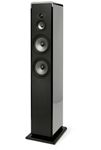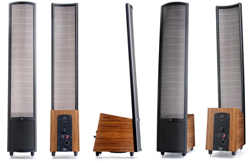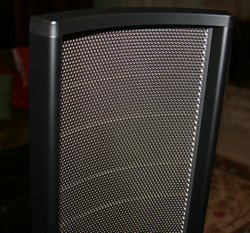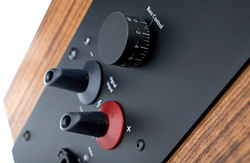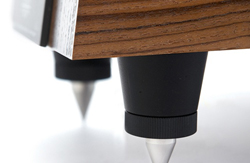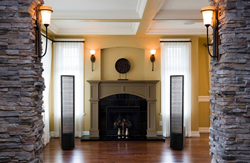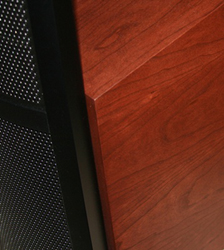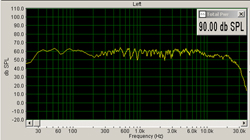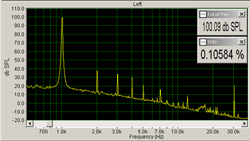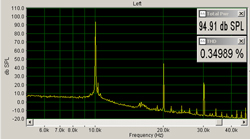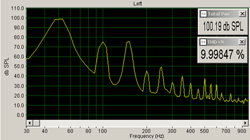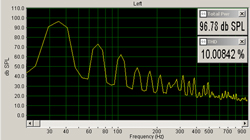Introduction
The clean-looking and clean-sounding Ethos speakers are a new model in MartinLogan’s Reserve ESL Series of electrostatic speakers. The Reserve ESL Series is MartinLogan’s top range of electrostatic speakers and the Ethos are near the middle of this series. The Ethos feature a 44″ x 9.2″ XStat™ CLS™ Transducer, a 200W 8-inch PoweredForce™ Woofer with an 8-inch Passive Radiator and a 24-bit Vojtko™ DSP Engine. The sub module has real wood veneer with three hand-rubbed finish options, the newest being the very gorgeous flamed teak. More finishes are coming soon. MartinLogan has pulled out all the stops when it comes to the Ethos speakers. How do these amazing speakers perform? Read on and you will see.
Specifications
- Design: Electrostatic Panel with Cone Woofer (Hybrid Design)
- MFR: 34 Hz –23 kHz ± 3 dB
- Horizontal Dispersion: 30°
- Electrostatic Panel Dimensions: 44″ H × 9.2″ W
- Woofer: 8″ Aluminum Cone
- Passive Radiator: 8″ Polypropylene
- Crossover Frequency: 375 Hz
- Woofer Amplifier: 200 Watts RMS, Class D
- Sensitivity: 92 dB/2.83 Volts/Meter
- Nominal Impedance: 4 Ohms, 0.8 Ohms at 20 kHz
- Recommended Amplifier Power: 20?500 Watts per Channel
- Tone Control: ± 10 dB under 100 Hz
- Inputs: Custom 5-way Binding Posts
- Dimensions: 59.3″ H x 10.7″ W x 18.2″ D
- Weight: 42 Pounds/each
- MSRP: $6,495/pair USA
- Martin Logan
Design
I usually gather technical information about the products I am reviewing. This information helps me understand, evaluate and report on the products. I typically call and e-mail the manufacturer’s technical experts to get this information. They will send me technical white papers that supplement the information on their website or in the product’s owners’ manual.
In the case of the MartinLogan Ethos speakers, I didn’t have to do any of that. The speakers shipped with a most excellent owners’ manual which was well written, well organized and chock full of useful information. There was probably more information in the MartinLogan 28 page manual than I find in many other manufacturers’ technical white papers. I’d venture that MartinLogan believes (or realizes) that their clientele is suitably knowledgeable and can benefit from this information. I’d bet they are right about that, too.
Most MartinLogan speakers feature a large mid/high electrostatic driver. These drivers and their design and technology are at the core of the MartinLogan “ethos”. (How’s that for a double entendre?) Seriously, though, MartinLogan has invested a great deal in advancing this technology and one area that the manual covers in detail is the history of electrostatic driver technology. I would like to summarize that history below.
Electrostatic drivers were originally pioneered by C.W. Rice and E.W. Kellogg of Bell Labs in the 1920’s to develop a loudspeaker technology for amplified music. They made a working prototype but ultimately recommended the active cone over the electrostatic and some other technologies they investigated. Their original design was patterned after the condenser. It only had one charged plate. The unit was plagued with low sensitivity and they could not get good bass response from a reasonably sized unit. Consequently, the technology was not considered commercially viable at the time.
Later, Arthur Janszen developed a HF electrostatic driver for the Navy that was used for testing microphone arrays. It was favored over dynamic cones due to its inherently benign phase angle and flat frequency response. He developed a viable tweeter element by the early 50’s that created quite a buzz in audio circles. It worked well because it was a push-pull arrangement with a constant charge on the diaphragm where earlier designs varied the charge on the diaphragm while maintaining a constant voltage.
In the mid 50’s, Englishman Peter Walker carried electrostatic technology even further. His efforts culminated with the introduction of the Quad ESL’s in 1956. This is when the technology really became a successful commercial product.
The biggest developmental hurdles for the technology were low power handling, low sensitivity, poor dispersion, limited low frequency response and possible damage of the units due to arcing. The greatest advantages of electrostatics were good transients (because all parts of diaphragm are loaded), low distortion and a non-reactive load (but they did exhibit low impedance at high frequencies).
MartinLogan officially started production in 1983. They have worked continuously to overcome the disadvantages of electrostatic technology while enhancing the advantages of the technology. Their efforts have produced a number of patents and trademarks. These MartinLogan exclusives provide an excellent overview of the Ethos speakers. I thought it would be fun to elaborate on them in this mini glossary:
AirFrameTM – This is the name given to the extruded aluminum structure that surrounds the electrostatic panel. It supports the panel and provides sonic and electrical isolation. The latest version of this technology maximizes the active membrane area and enhances the dipole dispersion pattern of the unit.
ClearSparTM – The clear spacers which suspend the membrane between the stators. These prevent grounding of the membrane. In the Ethos, they appear to be staggered vertically, presumably to avoid resonances or natural modes.
CLSTM (Curvilinear Line Source) – The panel is curved in the horizontal plane to produce a controlled horizontal radiation pattern that is free of the “venetian blind effect” which is common among large flat panel speakers.
EthosTM – The amazing speakers under review here.
Generation 2 Diaphragm – This transparent membrane has uniform surface resistivity characteristics and is nearly mass less. The Generation 2 Diaphragm is just 0.0005 of an inch thick. Its design reduces the possibility of damage because it resists arcing between the stators.
MicroPerf Stator – This is the new stator for the XStatTM panels. It reveals more open vibrating area of the panel so the panel can be reduced to almost ½ the size for an equivalent level of performance. (MartinLogan may consider a honeycomb pattern in the future as the hexagon provides the greatest opening for the least amount of material, but the corners in the pattern may be sites for potential arcing.)
PoweredForceTM – This is the bass unit supporting the Ethos speakers. It is a remarkable achievement for an 8″ compact sub to be able to produce 100 dB of continuous output at 50 Hz with a clean spectrum. I was able to obtain this level of performance in the bench testing below. These powered bass units have built-in protection circuitry.
Vacuum Bonding – This proprietary system ensures uniform diaphragm tensioning and precise manufacturing tolerances.
XStatTM – This is the latest iteration of the famous MartinLogan electrostatic panel. It “incorporate[s] a myriad of technology and design innovations including CLSTM, MicroPerfTM, Generation 2 Diaphragms, ClearSparsTM and Vacuum Bonding.”
Setup
Electrostatic speakers require external power to create the electrostatic field that excites the membrane. MartinLogan and other makers of electrostatic speakers make models that are 100% electrostatic. These speakers are usually large, expensive and do not have great bass extension. So most MartinLogan speakers have powered bass units which serve as the foundation of the loudspeaker.
Not all MartinLogan hybrids have powered subs. The sister model to the Ethos are the Theos which have passive subs and can be bi-wired or bi-amped. Getting back to the Ethos, they have high quality powered subs included that cross over at 375Hz. Because of this, there is only one set of binding posts. The posts are very easy to tighten by hand as they have wings, a sort of plastic wing nut. These are among my most favorite binding posts of all time.
The Ethos also come with two sets of adjustable floor spikes. One set has blunt, rubber tips and the other set has sharp metal tips. By sharp, I mean SHARP. Be careful. The audiophile in me loved the sharp metal spikes because they really coupled to the floor. Just please be extra careful because they’re really sharp.
Probably the two biggest placement issues with electrostatic speakers would be their separation with respect to the listening position and their spacing from the front wall. The MartinLogan Ethos speakers have the Curvilinear Line Source panels which promote improved dispersion of the sound as opposed to flat panels. I did find that these speakers should not be placed nearly as far apart as conventional speakers. I usually place stereo towers about 9′ or 10′ apart in my room. With the Ethos, I placed them about 8′ apart while the prime listening position was roughly 11′ from the speakers. I also toed in the speakers in accordance with the directions provided. This meant that their central axes converged about 4′ behind my head.
One should take care to place the Ethos away from the front wall. These speakers are dipoles and the rear reflections should return from the front wall with the least interaction with the boundary as possible. If the rear waves are absorbed or indiscriminately diffused, then the image can get muddied or become unfocused.
The Ethos have a sub level control that provides +/- 10 db contour control below 100 Hz. I left this on flat the whole time as I was able to get smooth bass response by simply tweaking the speakers’ positions. It is a nice touch, though for those whose rooms are a bigger challenge. And the large knob has a wide range of control, a precise feel and has ½ db graduations. Most Ethos owners would probably have their dealer set this control after break-in.
One knock on electrostatic speakers is that they have a narrow sweet spot. This is true, but I found the Ethos no better or worse than most of the dynamic towers I have reviewed. Their panels are tall, narrow and curved. If I sat anywhere between the speakers, the soundstage was just fine. If you sit right in front of or beyond the outer edge of one of the speakers, then the sound will tend to collapse into the speaker that is closest to you. This happens with conventional speakers too.
The Ethos speakers, like all MartinLogan speakers, make a strong visual statement in the room. They always generated lots of interesting comments from our guests. One of our friends thinks that MartinLogan ought to make the panels light up (cringe). I guess she thinks the lights could change colors to the music too, sort of like the visualizations on your PC’s media player (double cringe). I even had other people say that the Ethos speakers were symbolic of a particular masculine object (sigh).
My opinion? I love the look of them. They are high tech and transparent. The transparent look matches up with their transparent sound. I also like the real wood finish on the sub modules. This is high grade cabinetry. And the AirFrames do not overlap the sub modules as seen in some other MarinLogan models. The Ethos have a cleaner look.
In Use
When it comes to electrostatic speakers, I have always thought that the internal drive circuitry may be a limiting factor in the reproduction chain. I’ve long wondered if this circuitry might color the sound and obviate the need to move up to a better amp. Boy, was I wrong.
I used no less than four different amps with the Ethos and the Ethos revealed even the most subtle differences in the sound of each amp. I started with an Integra receiver, but that left me wanting. Not enough power or current. So I pulled out a stereo Crown amp from the closet. It had much more power and much more current . . . now we were getting somewhere. Next, I tried the new Primare A30.7 Class D amp and that was better still. But, finally, I drove the Ethos with a pair of Mark Levinson No 531H monoblocks. The Levinson No 531H amps are rated at 500 watts into 4 ohms and sounded fabulous through the Ethos. These were the amps I used for most of the review.
My point is that the Ethos are plenty good enough to warrant investment in a high quality amp. I could hear the sonic signature of each amp through the Ethos. I also found that they thrived with lots of power. They never flinched even once.

I am a pretty big fan of Helene Grimaud. I listened to the stereo track of the SACD Credo through the Ethos. The first half of the title track is an example of aleatoricism which is the creation of art by random chance. It is a raucous piece that can sound like a cacophony on lesser speakers but maintained a civilized panache through the Ethos. The second part of this movement contrasted the aleoric with an arrangement of a prelude by Bach. This is my favorite part.
On track 4, Allegretto, the piano solo was about as close as it gets to the sound of an actual piano in the room. Ms. Grimaud’s virtuoso playing came through the Ethos with lots of air around the notes. Trills on the piano, for example, retained their full texture with ample space between each key stroke.
Track 6 was recorded live and I could hear each instrument in the orchestra, not just a mass of strings. The presentation put me at about row 25 and the Ethos played to live levels with no strain. I inexplicably thought of fractal geometry at this point. All speakers can probably be modeled by fractal geometry. It’s just that the Ethos would require a much larger data set than most others.
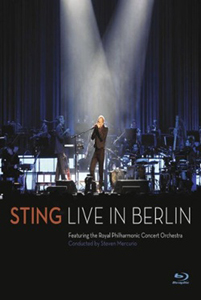
Here is a new concert Blu-ray that was recorded just this last summer. Sting Live in Berlin has Sting performing his classic songs alongside the Berlin Philharmonic. The pieces have been “re-imagined” for orchestra. The very entertaining conductor is Steven Mercurio who jumps around quite a bit. Branford Marsalis is the featured guest on a number of the tracks. All the tracks are stand outs, but I enjoyed “Roxanne”, “Englishman in New York”, “This Cowboy Song”, “Moon over Bourbon Street” and “All Would Envy” the most. This time, I felt like I was a little closer to the stage. Maybe row fifteen. The picture quality is quite good on this disc, by the way.
I was listening in stereo mode and still enjoyed an excellent sense of arena space. The Ethos had a balanced sound with a delicate top end and a full but slightly rolled-off bass. Sting was on fire on Roxanne. He is a real pro who performs with lots of heart. Throughout this disc, the Ethos passed along the full scale and majesty of the orchestra. The soundstage was at least 3′ outside the speakers. I almost fell out of my chair when Sting started playing a Theremin on “Moon over Bourbon Street”. You don’t see that every day!
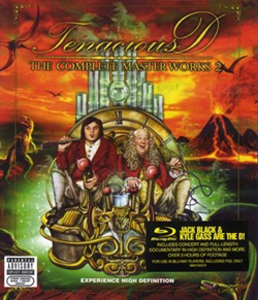
So how about a little Tenacious D, the Complete Master Works 2? This live concert Blu-ray disc is pure modern rock opera. Maybe I should have guessed that the Devil was in to speed metal. Jack Black and Kyle Gass come across so tongue in cheek that I couldn’t stop asking myself, “Is this art?”
I rocked out hard to the very lifelike presentation over the Ethos. The driving bass lines were clean and powerful with excellent, forceful impact throughout the all-important power band. This disc really demonstrated the amazing transient response of the Ethos. Even though I was listening at pretty high levels, I had no discernable symptoms of fatigue at the end of the show. I gave Tenacious D and the Ethos a standing ovation!
So, how did the Ethos do on movies? I pulled out the Blu Ray of American Gangster. This Ridley Scott film is a good choice for sound system evaluation. It has lots of music, environmental sounds and special effects. It has the added benefit of being a very entertaining film to boot.

My first impression was that I really like having stereo subs. The subs tend to blend and cancel much of the room interactions. While the Ethos gave it the old college try, I would recommend that you throw in a high quality sub crossed over at about 40 Hz for movies and pipe organ. That’s because the Ethos, in practice, rolled off at about 35 Hz. I suggest that you consider one of MartinLogan’s excellent stand-alone subs for this purpose.
I really connected to the movie’s sound effects through the Ethos speakers. The effects had a highly tangible and see-through quality. Note that the Ethos do indeed require upwards of 100 hours of playing time to sound their best. Not only did the bass fill out, but the whole sound of the speakers went from wooden to liquid over this intermediary period. If you don’t believe me, just check out the jungle scenes in American Gangster and then you will understand the importance of a proper break-in for audiophile speakers.
On the Bench
All the below measurements shown are in-room response. The frequency response tests were performed at 1-meter, the upper unit distortion measurements were on axis near field measurements and the distortion readings for the sub were taken at 1-meter on-axis.
The on-axis response of the Martin-Logan Ethos shows an exceptionally flat spectrum from 30 Hz to 20 kHz. There is usable response all the way out to 30 kHz.
At 30 degrees off-axis, the Ethos speakers had a response curve that was not as smooth as the on-axis test, but it doesn’t really roll off any quicker in the upper registers, demonstrating that Martin-Logan has created a speaker with sufficient dispersion at this offset.
The THD at 1 kHz and 100 db was very low at 0.10%, with the first harmonic more than 60 db below the signal. This is excellent performance.
At 500 Hz and 100 db, the THD measurement is an inaudible 0.22%.
At 10 kHz and 95 db, the distortion rises to 0.35% with the second harmonic above the threshold of human hearing.
The first test of the powered sub is at 250 Hz and 100 db. The distortion is very low here, 1.6%. Keep in mind that this is just one of the subs in operation.
The sub achieved 100 db at 50 Hz at less than 10% THD + N. This is just one of the subs being driven. 10% THD+N is considered acceptable distortion at this frequency.
Here you see that the sub maxed out at precisely 10% THD and 97 db when tested at 35 Hz. Again, this is excellent performance for a single 8″ subwoofer.
Conclusions
I have had the MartinLogan Ethos speakers in my system for several weeks and I am becoming progressively more sleep deprived by the day. That’s because I have been staying up to the wee hours of the night playing all kinds of music. With good source material, the Ethos will paint an extremely beautiful picture of the sound. Most of these songs sound as if I am listening to them for the very first time.
The hallmarks of the Ethos sound are transparency, low distortion, natural transients, pinpoint imaging, the ability to render complex passages and a natural harmonic structure. The Ethos have capably handled every genre of music I’ve thrown at them, all the way from chamber music to heavy metal. The Ethos are true audiophile speakers in every sense of the word and they reveal the sonic character of the rest of your equipment for better or worse.
I think MartinLogan has a real winner of a speaker in the Ethos. My respect for them grows each and every day. I believe that life is short and you should go all in when you can. But why spend tens of thousands of dollars to get there when the Ethos are priced at just $6,500 a pair? Give them a try; you will probably agree with me that they perform far better than speakers costing much, much more.


